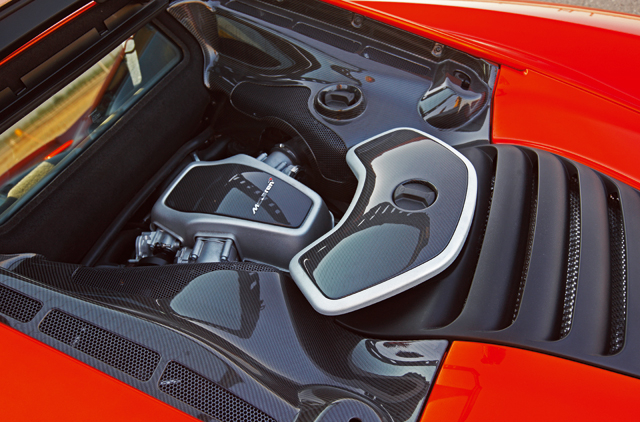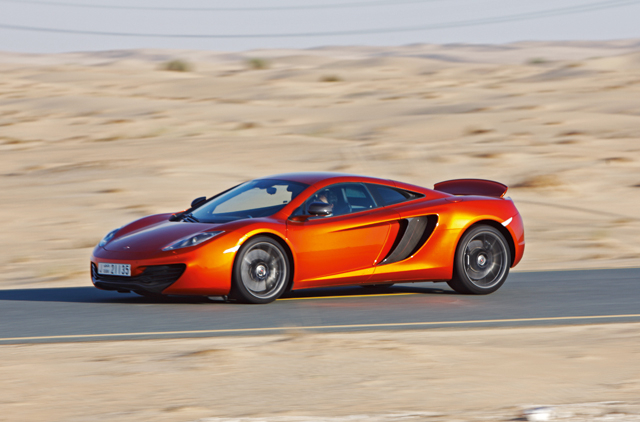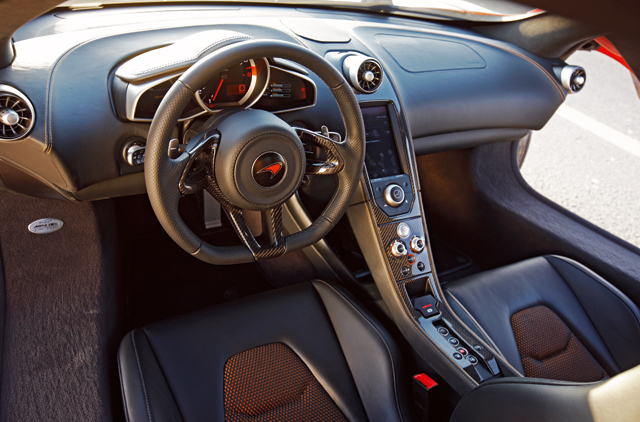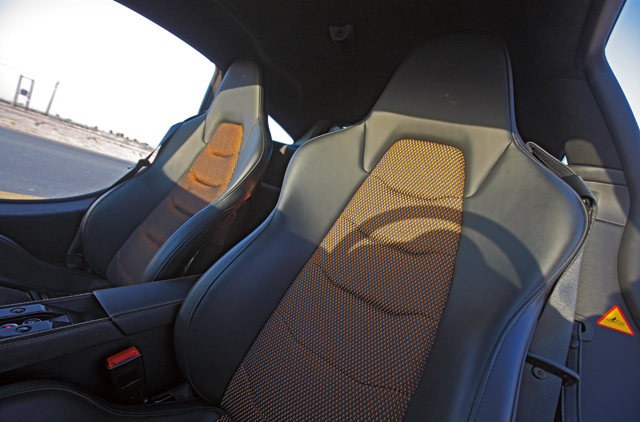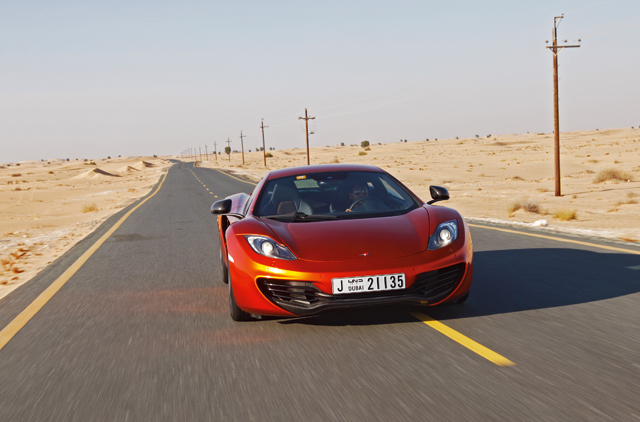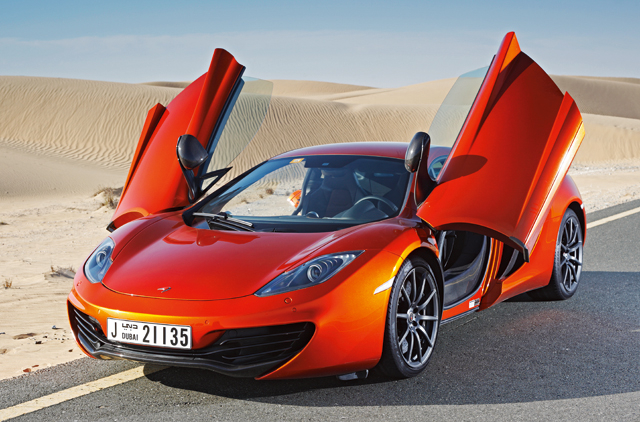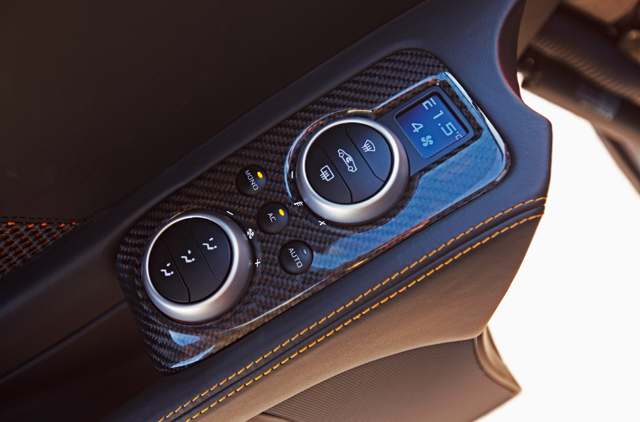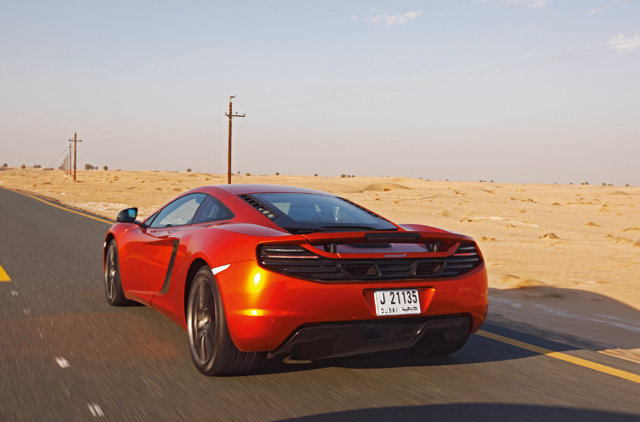
I'm standing on an empty stretch of road, tucked away deep in the deserts of Dubai. Rows upon rows of dunes ebb and flow as far as the eye can see and the tarry black asphalt melts into the horizon; it's a magnificent setting. But the centrepiece of this spectacular scene is the brand new McLaren MP4-12C parked in front of me, its insect-wing door stretching skywards and the busy little V8 burbling away intently. The sun glistening off of its shiny bright orange bodywork is making my eyeballs wince. Luckily though, I have no intention of gazing at the wind-tunnel honed contours of the Macca. There's work to do. It's finally my turn to get behind the wheel of a car whose arrival is steeped in expectation. McLaren insists that the MP4 is the best supercar in the world — it's even got hard, scientific evidence to back the claim.
Swirl these numbers around in your mouth for a while: Its 3.8-litre flat-plan crank V8 develops 593bhp. Yet, it only spews 0.47 g/km-per-bhp of CO2 and judicious use of throttle will return around 9.0 litres-per-100km. It weighsa faintly ridiculous 1,300kg dry, and even with all the fluids coursing through its system, it's lighter than the 458 Italia. Those numbers are a huge achievement for a 300kph+ rocketship. But one that's taken five years of painstaking development work and some very, very clever packaging and technology.
For example, to keep the weight down McLaren looked beyond obvious solutions. The exhausts exit high up at engine level to reduce the amount of plumbing, consequently saving weight and also clearing space for the massive rear diffuser. The pop-up air-brake, meanwhile, is unburdened by a heavy hydraulic pump and is hoisted by the pressure generated by ancillary systems. Another highlight is the carbon monotub, which forms the backbone of the car and tips the scales at just 75kg. Usually the preserve of hyper-exotics, such as McLaren's eponymous F1, each monotub requires a small fortune and several days to build, but the boffins at Woking have found a way to stamp one out every four hours and at a fraction of the cost! Is your head spinning yet?
There's more. McLaren also ditched conventional anti-roll bars for a clever hydraulic system, that makes all four wheels truly independent and squat and pitch are tackled in real time by active dampers. Apart from the standard double wishbones and Eibach springs, there's a hydraulic cylinder at each wheel. The damping is governed by the amount of hydraulic fluid pumped into or out of the accumulators. So, the ride characteristics can vary from super-stiff to milk-and-honey consistency at the flick of a switch.
With the MP4-12C, McLaren wanted to build a supercar that was easy to drive and crucially, usable everyday and it's sort of pulled it off. The steering's light and unlike others of its ilk the MP4 isn't impossibly wide, and is therefore easy to manoeuvre in and out of tight spaces. And surprisingly, despite the slender proportions, the interior accommodation doesn't suffer at all.
Cue more cleverness. The centre console only houses the touchscreen system and controls for dynamic settings of the car. The knobs and buttons for air conditioning are moved to the doors to facilitate a narrow console and liberate more room for the occupants.
The steering wheel — which for reasons unfathomable is exactly the same thickness as the one in Lewis Hamilton's F1 car — meanwhile isn't littered with unnecessary switchgear. It's a modernand minimalist design driven purelyby functionality.
In fact, function takes precedence over everything else in this car. Even the exterior design is honed by airflow rather than the masterful strokes of an impassioned designer's pen. It won't have you clutching your heart like, say, a 458 Italia would.
Walk around the car and you're gobsmacked by the sheer number of scoops and vents. And the only standout styling flourishes are the two sharp character lines running along the length of the car — a nod to the F1 hypercar — and the shark-gill elements in the headlamps. Overall, it's an uninspiring piece of design. But one that somehow still turns heads.
And that makes it doubly embarrassing when just getting in requires you to stroke the car extensively. Let me explain. Since the engineers didn't want rudimentary handles unsettling the airflow around the MP4, there is a touch-sensitive switch to open the door. It's a great idea, in theory: run your fingers under the cutlines and Ron's your uncle. In practice, it's trickier and it takes several frustrating swipes just to get the darned thing to yield. By which time you will have doubtless evoked bouts of laughter from camera-phone-toting onlookers, and perhaps earned the dubious distinction as someone with an unhealthy and misplaced relationship with their car. However, that's the least of my worries in these desolate surroundings.
Once inside you're immediately drawn to the start button that sits enticingly within reach. Press it and the ominous whirr of the starter motor lingers slightly longer than usual. You expectantly wait for an almighty explosion of engine noise and thunder as the twin-turbo V8 awakens. It never comes. The MP4 starts with an apologetically muted whump that settles into the background pronto.
Pottering around in Normal mode it's uncannily comfortable, too. The ride is by far the best on any supercar around and the Graziano-developed seven-speed twin clutch gearbox does a fine job of emulating the smooth shift operation of a conventional torque converter auto. There's no recalcitrance or frightening lurches, and to be honest, it's all depressingly undramatic.
As a result, you're utterly ill-prepared for what's to come next. Nail the throttle, the rev-needle charges towards the 8,500rpm redline and your skull is flung into the headrest with a degree of violence that belies the car's mild manners. It's like being punched squarely in the forehead. And hard.
With 593 horses providing the motivation, there's no deliberation, no hesitation, and once the turbos reach their peak boost, an almighty gush of 600Nm of torque whisks you away to break-neck velocity in a matter of seconds. Zero to 100kph is dealt with in 3.1 seconds, 200kph in 9.1 and it only runs out of breath at 330kph. It's a devastatingly rapid car.
The Ricordo-built engine is a gem; there isn't even a mild suggestion of turbo lag and the occasional wastegate chatter is the only giveaway of its blown nature.
Over in Maranello, arch rival Ferrari is proud of its complex manettino multi-stage traction-control system, but McLaren is on a different level of fiddliness. You have to press the Active button on the console to invoke the magical powers of two similar systems — one for chassis and the other for suspension. Both have three modes, which means you can mix and match and set up the car exactly to your liking. It's brilliant.
Switch to Sport and you're greeted with all manner of whooshing and whizzing, signalling the activation of Defcon 2. The ride becomes choppy, more engine noise seeps into the cabin and everything becomes nicely sharp and pointy.
However, it's in full-attack, Track mode where the 12C really comes alive. Traction control slinks into the background, gear changes are kidney-jab aggressive and the ride is rendered unsettlingly stern. And from there on out it's a staring competition between man and car. And the car wins every time. Try as you might, you will never be able to experience the upper reaches of the MP4's abilities on public roads. The grip is brain-scrambling and though easily on a par with AWD monsters such as the Nissan GT-R, the MP4 feels more organic and fluid. The turn-in response is supernaturally good too, but I have to admit, the Italia reacts to the driver's bidding with more alacrity.
Enter a corner at furious pace and the computers spring into action to clamp the inside rear anchors to suppress understeer. And if you get over-zealous with the throttle on the way out, the tail steps out ever so slightly before being gently pulled back into line by stability control. You have to be scraping the bottom of driver-talent barrel to spin this car.
The last piece in the performance jigsaw is the rear-mounted gearbox, which pre-loads the clutch with half-a-pull of the F1-style rocker arrangement to ensure rapid-fire changes. And if you hold the paddle while braking, it will scythe through the ratios to find the optimal gear. Sadly though, unlike the Ferrari or the Lambo, there are no aural histrionics when you downshift. It's all disappointingly quiet.
Other complaints? The front wheels intrude a bit too much into the footwell, compromising room for your left leg and the optional carbon brakes are detestable in city driving and should be avoided.
Verdict
McLaren boss Ron Dennis is known for his uncompromising and stern approach — his racing team didn't win one out of every four Grands Prix without reason. So when the company set about building the MP4, the remit was simple: create the technologically most advanced supercar around. And what Ron wants, Ron gets. Here's proof.
Specs & ratings
- Model MP4-12C
- Engine 3.8-litre V8 twin-turbo
- Transmission Seven-speed auto, RWD
- Max power 593bhp @ 7,000rpm
- Max torque 600Nm @ 3,000pm
- Top speed 330kph
- 0-100kph 3.1sec (with Corsa tyres)
- Price Dh925,000 (base)


